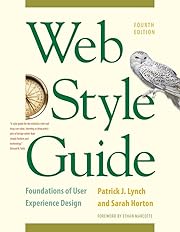

Klik op een omslag om naar Google Boeken te gaan.
|
Bezig met laden... Web Style Guide, 4th Edition: Foundations of User Experience Design (editie 2016)door Patrick J. Lynch (Auteur), Sarah Horton (Auteur), Ethan Marcotte (Voorwoord)
Informatie over het werkWeb Style Guide, 4th Edition: Foundations of User Experience Design door Patrick J. Lynch
Geen Bezig met laden...
Meld je aan bij LibraryThing om erachter te komen of je dit boek goed zult vinden. Op dit moment geen Discussie gesprekken over dit boek. geen besprekingen | voeg een bespreking toe
This book explains established design principles and covers all aspects of web design--from planning to production to maintenance. The guide also shows how these principles apply in web design projects whose primary concerns are information design, interface design, and efficient search and navigation. Geen bibliotheekbeschrijvingen gevonden. |
Actuele discussiesGeen
 Google Books — Bezig met laden... Google Books — Bezig met laden...GenresDewey Decimale Classificatie (DDC)006.7Information Computer Science; Knowledge and Systems Special Topics Multimedia systemsLC-classificatieWaarderingGemiddelde: (3.67) (3.67)
Ben jij dit?Word een LibraryThing Auteur. |
||||||||||||||||||||||||||||||||||||||||||||||||||||||||||||||||||||||||||||||||||||||||||||||||||||||||||||||||||||||||||||||||||||||||
While being comprehensive, this book profoundly offers readers with challenges that take a lifetime to master. For instance, within 35 pages, the chapter on typography contains a summary of the field over hundreds of years. Other chapters intelligently tie to traditional design concepts and illustrate why web design is slightly but importantly different than printed paper.
Understanding how and why things have evolved because of technology especially helped me as a software developer. Some books are too low-level in computer languages to grasp design trends. Likewise, other books on design style focus on artistic trends to the neglect of technological innovation. This book integrates the two and focuses on how the innovation drives the style. For instance, discussion on relatively new retina displays show how assumptions about screen size change visual planning.
Of course, the world has changed since 2016. I write this five years later in 2021 and notice that the last two chapters (respectively on images and video) are already somewhat out of date. I hope the publishers continue to update this guide in a fifth edition sometime to allow it to stay current.
This style guide is written in plain English for designers to take advantage of. Computer programmers still can benefit from understanding what others on the team are explaining. Also, those designers – who are not coders – can and should read this book as it provides a basic understanding of the technological trends driving the team of web designers. Artisans can also grasp how physical constraints can change the process of production.
This book fills a need for a style guide for the web. For the above reasons, editors, developers, graphic designers, and IT managers can all benefit from reading this guide. Websites are often put together in an ad hoc manner that, for better or for worse, imitate each other. Lynch and Horton provide some helpful and reasoned depth to the practice. This has the potential to grow into something evermore timeless, and I hope it succeeds in that task as it moves into its third decade in production. The web is here to stay, and Lynch and Horton make sure that style will be present as well. (